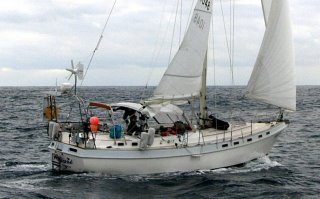There are two anchorages at Barra de Navidad. One is in front of the town of Melague on the north side of the bay. It's open to the swells from the ocean that wrap around the protecting point and dinghy landing is thru the surf which is usually too large to negotiate in the afternoons. It is however, easy to enter and probably bug free.
The other anchorage is in the lagoon next to the town of Barra de Navidad. Lots of bugs at sunset but on the other hand absolutely no swells and you can take your dinghy to a very civilized dinghy dock at a hotel. Speaking of civilized, a local baker takes a small boat around the lagoon selling fresh pastry every morning. Also there is water taxi service 24 hours a day to take you to or from your boat.
What is the downside of the lagoon? Getting your boat into the anchorage can be a challenge. In fact at our last anchorage we were given a four-page info sheet on this area much of which is detailing how to get from the bay into the lagoon. The channel into the anchorage is marked with aids to navigation for the first half. The channel is narrow and the sides are very steep so the depth meter doesn't help because when the front of the boat runs aground the boats center, where the depth meter is, still shows enough water. The sides are mud so no damage is done to the boat, just to the skippers' pride.
Vagari planned to stop for fuel and water. The fuel dock is off the main channel in the unmarked end of the channel. With Rhea spotting from the very front of the boat we were almost half way in when a friend called on the radio. We were about an hour behind them making the same passage and they were getting fuel also. They ask us how far we were from the fuel dock. About two minutes we said. "Not good because the dock is full and will be for another 25 minutes," they replied.
Turning around is not an option in a narrow channel so they advised that we anchor in the side channel and wait for boats to clear. Just then a cruising friend in a dinghy pulled up next to us and told us that we picked a poor time because the tide was really low. In fact he had just run aground in his dinghy that takes well less than two feet of water. We planned to enter at low tide so that if we do run aground the rising tide will float us off.
We negotiate the turn into the side channel and see a large motor yacht on one side and our friends and a powerboat on the other side of the fuel dock. We shift from the tie up mode to the anchor mode in a flash. We find what looks like a safe place and drop the anchor. Up comes another dinghy with two ladies. They politely ask if we are OK. Really asking what in the world are you doing. We tell them our problem and they kindly point out all the things we can swing into where we are anchored. We thank them for their advice and they leave.
I look around and see another problem. We have anchored in an area where a cable crosses the channel. My Spanish is limited but the sign says something to the effect that if you are foolish enough to anchor here you will spend a long time starving in prison.
Up goes the anchor as fast as it went down. By this time Vagari has turned around on the anchor so we go all the way back to the ocean. Two minutes after reaching the open ocean our friends' radio saying the fuel dock is open now.
We fueled, filled both water tanks and our five-gallon gas tank for the outboard and generator and made a clean entry into the anchorage area. Forty gallons of diesel fuel cost 1,106 pesos including a thirty percent service fee or about $2.60 US a gallon. The 200 gallons of water was "free". We didn't completely fill the diesel tank because we will need some additional water when we leave.
Both Rhea and I were a little nervous about this anchorage because a cruising friend we visited with last summer told us he ran aground five times on the way in. And he didn't stop to fuel.
Don't get caught with egg on your face. Play Chicktionary! Check it out!

No comments:
Post a Comment